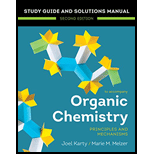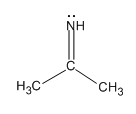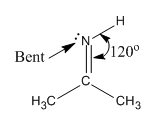
Concept explainers
Interpretation:
Molecular geometry and electron geometry about nitrogen atom in the acetone imine molecule is to be predicted.
Concept introduction:
Electron geometry and molecular geometry of molecules is determined by using Valence shell electron pair repulsion (VSEPR) theory. According to VSEPR theory, electron geometry describes the orientation of the electron groups about a particular atom, and molecular geometry describes the arrangement of atoms about a particular atom.
Number of electron pairs describes the electron and molecular geometry. If all the electron pairs are bonds, then molecular geometry is the same as electron geometry. Electron geometry is different from molecular geometry if some electron pairs are present as lone pairs.
Electron geometry and molecular geometry from the number of electron pairs are as follows:
| Number of electron pairs |
Number of Bonds |
Number of Lone pair |
Electron geometry | Molecular Geometry |
| 2 | 2 | 0 | Linear | Linear |
| 3 | 3 | 0 | Trigonal planar | Trigonal planer |
| 3 | 2 | 1 | Trigonal planar | Bent |
Answer to Problem 2.1P
Electron geometry about N atom in acetone imine molecule geometry is trigonal planar and molecular geometry is bent.
Explanation of Solution
The given acetone imine molecule is

In acetone imine molecule, there are total three groups of electrons about N atom. There is one double bond, one single bond, and one lone pair around N atom, that is, all electron pairs are not involved in bond formation, and hence, molecular geometry and electron geometry are different.
There are total three electron groups, hence, the electron geometry about N atom is trigonal planar. The molecular geometry is bent.

Electron geometry and molecular geometry about N atom is predicted from the number of electron pairs present around the atom in the given molecule.
Want to see more full solutions like this?
Chapter 2 Solutions
Organic Chemistry: Principles And Mechanisms: Study Guide/solutions Manual (second)
- H I T H HH H -H C. H- Identify and select all structures below that represent a constitutional isomer(s) of the compound shown above. H- H CIH H H H HHHH H H 0 ·H H– 冊 CH CHI HH C- H- H H- H H A. H H C H H- -H HH H B. H- -H D. H H H H • H -H E. -H H H HICH T HHH F. H-arrow_forwardPolylactic acid (shown below) is a biodegradable polymer used for food packaging. Identify the monomer(s) used in the production of this polymer using a condensation process.arrow_forwardDraw the product of the reaction shown below. Ignore small byproducts that would evaporate pleasearrow_forward
- Poly(ethylene adipate) is a biodegradable polyester (shown below). Identify the type of polymerization process used in the production of this polymer.arrow_forwardPolymers may be composed of thousands of monomers. draw two repeat units(dimer) of the polymer formed in this reaction. assume there are hydrogen atoms on the two ends of the dimer. ignore inorganic byproducts pleasearrow_forwardDraw the product of the reaction shown below. Use a dash or wedge bond to indicate stereochemistry of substituents on asymmetric centers, Ignore inorganic byproductsarrow_forward
- Draw the product of this reaction please. Ignore inorganic byproductsarrow_forwardOne of the pi molecular orbitals of 1,3-butadiene (CH2=CHCH=CH2) is shown below. Please identify the number of nodal planes perpendicular to the bonding axisarrow_forwardDraw the monomers required to synthesize this condensation polymer please.arrow_forward
- Provide the correct systematic name for the compound shown here. Please take into account the keyboard options belowarrow_forwardcurved arrows are used to illustrate the flow of electrons. using the provided starting and product structures, draw the curved electron-pushing arrows for the following reaction or mechanistic step(s)arrow_forwardIdentify the 'cartoon' drawing of the acceptor orbital in the first mechanistic step of an electrophilic addition reaction of butadiene with HBr. Pleasearrow_forward

 Organic Chemistry: A Guided InquiryChemistryISBN:9780618974122Author:Andrei StraumanisPublisher:Cengage Learning
Organic Chemistry: A Guided InquiryChemistryISBN:9780618974122Author:Andrei StraumanisPublisher:Cengage Learning Chemistry for Today: General, Organic, and Bioche...ChemistryISBN:9781305960060Author:Spencer L. Seager, Michael R. Slabaugh, Maren S. HansenPublisher:Cengage Learning
Chemistry for Today: General, Organic, and Bioche...ChemistryISBN:9781305960060Author:Spencer L. Seager, Michael R. Slabaugh, Maren S. HansenPublisher:Cengage Learning



